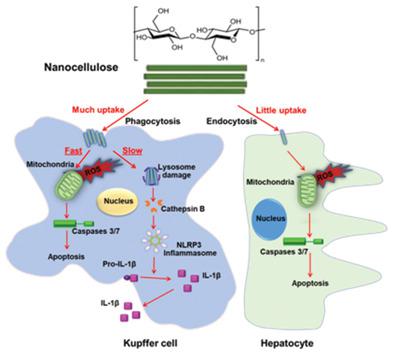Our official English website, www.x-mol.net, welcomes your
feedback! (Note: you will need to create a separate account there.)
Nanocellulose Length Determines the Differential Cytotoxic Effects and Inflammatory Responses in Macrophages and Hepatocytes
Small ( IF 13.0 ) Pub Date : 2021-08-06 , DOI: 10.1002/smll.202102545 Jiulong Li 1 , Xiang Wang 1, 2 , Chong Hyun Chang 1 , Jinhong Jiang 1 , Qi Liu 1 , Xiangsheng Liu 1 , Yu-Pei Liao 2 , Tiancong Ma 1 , Huan Meng 1, 2 , Tian Xia 1, 2
Small ( IF 13.0 ) Pub Date : 2021-08-06 , DOI: 10.1002/smll.202102545 Jiulong Li 1 , Xiang Wang 1, 2 , Chong Hyun Chang 1 , Jinhong Jiang 1 , Qi Liu 1 , Xiangsheng Liu 1 , Yu-Pei Liao 2 , Tiancong Ma 1 , Huan Meng 1, 2 , Tian Xia 1, 2
Affiliation

|
Nanocellulose including cellulose nanocrystal (CNC) and cellulose nanofiber (CNF) has attracted much attention due to its exceptional mechanical, chemical, and rheological properties. Although considered biocompatible, recent reports have demonstrated nanocellulose can be hazardous, including serving as drug carriers that accumulate in the liver. However, the nanocellulose effects on liver cells, including Kupffer cells (KCs) and hepatocytes are unclear. Here, the toxicity of nanocellulose with different lengths is compared, including the shorter CNCs (CNC-1, CNC-2, and CNC-3) and longer CNF (CNF-1 and CNF-2), to liver cells. While all CNCs triggered significant cytotoxicity in KCs and only CNC-2 induced toxicity to hepatocytes, CNFs failed to induce significant cytotoxicity due to their minimal cellular uptake. The phagocytosis of CNCs by KCs induced mitochondria ROS generation, caspase-3/7 activation, and apoptotic cell death as well as lysosomal damage, cathepsin B release, NLRP3 inflammasome and caspase-1 activation, and IL-1β production. The cellular uptake of CNC-2 by hepatocytes is through clathrin-mediated endocytosis, and it induced the caspase-3/7-mediated apoptosis. CNC-2 shows the highest levels of uptake and cytotoxicity among CNCs. These results demonstrate the length-dependent mechanisms of toxicity on liver cells in a cell type-dependent fashion, providing information to safely use nanocellulose for biomedical applications.
中文翻译:

纳米纤维素长度决定巨噬细胞和肝细胞中不同的细胞毒性作用和炎症反应
纳米纤维素,包括纤维素纳米晶体(CNC)和纤维素纳米纤维(CNF)由于其优异的机械、化学和流变性能而备受关注。尽管被认为具有生物相容性,但最近的报告表明纳米纤维素可能是危险的,包括作为药物载体在肝脏中积聚。然而,纳米纤维素对肝细胞(包括库普弗细胞(KC)和肝细胞)的影响尚不清楚。这里比较了不同长度的纳米纤维素,包括较短的 CNC(CNC-1、CNC-2 和 CNC-3)和较长的 CNF(CNF-1 和 CNF-2)对肝细胞的毒性。虽然所有 CNC 都会在 KC 中引发显着的细胞毒性,并且只有 CNC-2 会诱导肝细胞的毒性,但 CNF 由于其细胞摄取量极小,未能诱导显着的细胞毒性。KCs 对 CNC 的吞噬作用诱导线粒体 ROS 生成、caspase-3/7 激活和细胞凋亡以及溶酶体损伤、组织蛋白酶 B 释放、NLRP3 炎性体和 caspase-1 激活以及 IL-1β 产生。肝细胞通过网格蛋白介导的内吞作用摄取 CNC-2,并诱导 caspase-3/7 介导的细胞凋亡。CNC-2 在 CNC 中表现出最高水平的摄取和细胞毒性。这些结果以细胞类型依赖的方式证明了肝细胞毒性的长度依赖机制,为安全地将纳米纤维素用于生物医学应用提供了信息。
更新日期:2021-09-23
中文翻译:

纳米纤维素长度决定巨噬细胞和肝细胞中不同的细胞毒性作用和炎症反应
纳米纤维素,包括纤维素纳米晶体(CNC)和纤维素纳米纤维(CNF)由于其优异的机械、化学和流变性能而备受关注。尽管被认为具有生物相容性,但最近的报告表明纳米纤维素可能是危险的,包括作为药物载体在肝脏中积聚。然而,纳米纤维素对肝细胞(包括库普弗细胞(KC)和肝细胞)的影响尚不清楚。这里比较了不同长度的纳米纤维素,包括较短的 CNC(CNC-1、CNC-2 和 CNC-3)和较长的 CNF(CNF-1 和 CNF-2)对肝细胞的毒性。虽然所有 CNC 都会在 KC 中引发显着的细胞毒性,并且只有 CNC-2 会诱导肝细胞的毒性,但 CNF 由于其细胞摄取量极小,未能诱导显着的细胞毒性。KCs 对 CNC 的吞噬作用诱导线粒体 ROS 生成、caspase-3/7 激活和细胞凋亡以及溶酶体损伤、组织蛋白酶 B 释放、NLRP3 炎性体和 caspase-1 激活以及 IL-1β 产生。肝细胞通过网格蛋白介导的内吞作用摄取 CNC-2,并诱导 caspase-3/7 介导的细胞凋亡。CNC-2 在 CNC 中表现出最高水平的摄取和细胞毒性。这些结果以细胞类型依赖的方式证明了肝细胞毒性的长度依赖机制,为安全地将纳米纤维素用于生物医学应用提供了信息。











































 京公网安备 11010802027423号
京公网安备 11010802027423号